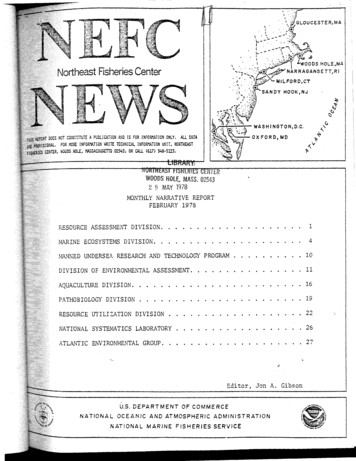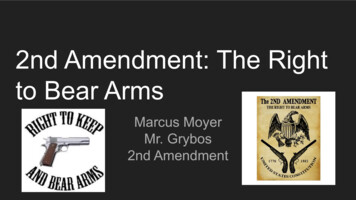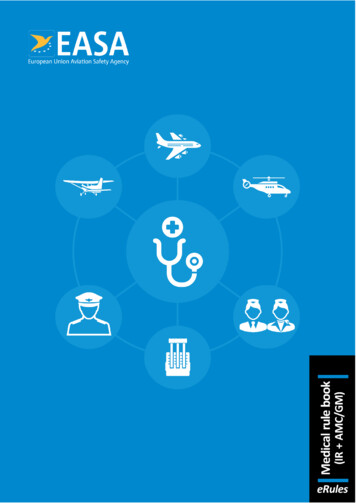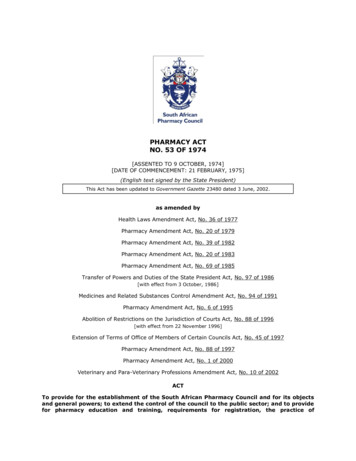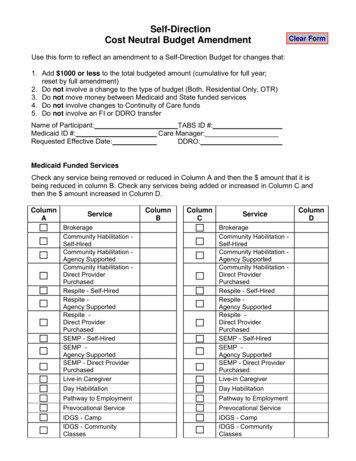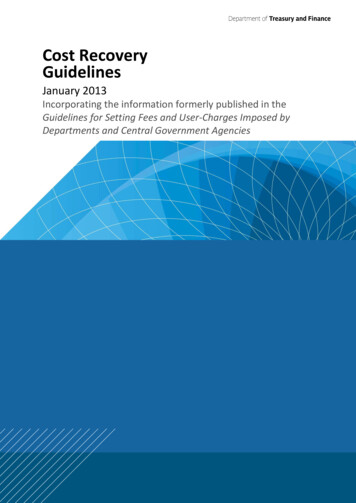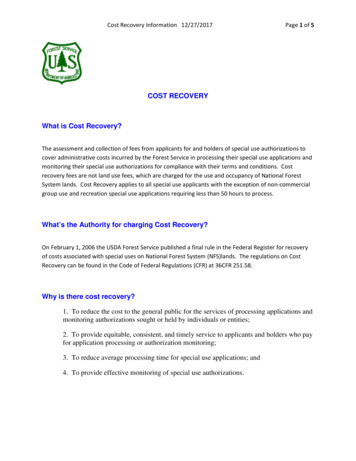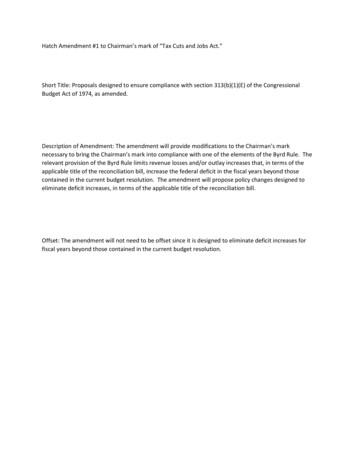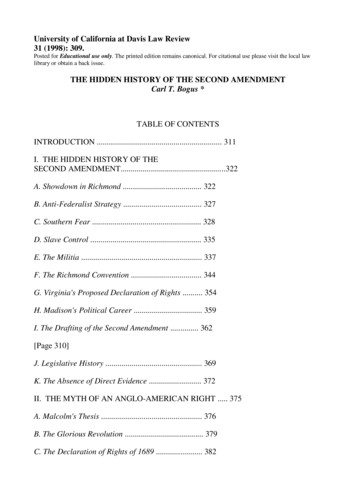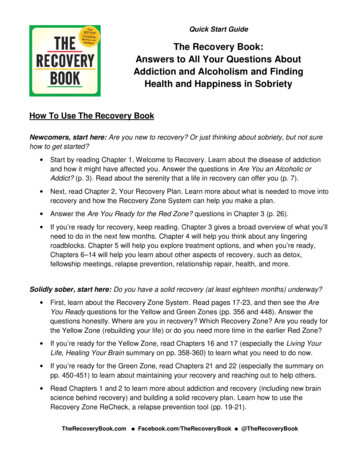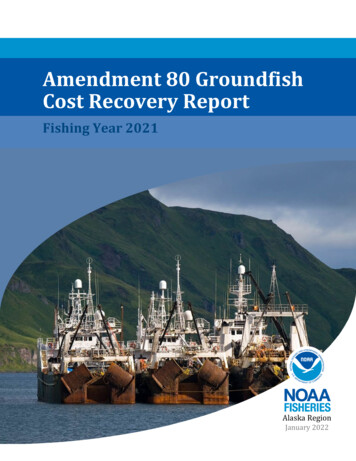
Transcription
Amendment 80 GroundfishCost Recovery ReportFishing Year 2021NOAAFISHERIESAlaska RegionJanuary 2022
Contact information:For more information about cost recovery and the CR Programplease visit ee-payment-alaska.For general questions contact Sustainable Fisheries Division at(907) 586-7228.For cost recovery billing questions contact the Fee Coordinator at(907) 586-7105.Disclaimer: Accessibility of this Document: Every effort has been made to make thisdocument accessible to individuals of all abilities and compliant with Section 508 of theRehabilitation Act. The complexity of this document may make access difficult for some.If you encounter information that you cannot access or use, please email usat alaska.webmaster@noaa.gov or call us at 907-586-7228 so that we may assist you.U.S. Department of Commerce National Oceanic and Atmospheric Administration National Marine Fisheries Service
Amendment 80 Program Cost Recovery for Fishing Year 2021Cost recoverySection 304(d) of the Magnuson-Stevens Fishery Conservation and Management Act(Magnuson-Stevens Act) authorizes and requires the collection of cost recovery fees for limitedaccess privilege programs (LAPP) and the Community Development Quota Program. Costrecovery fees recover the actual costs directly related to the management, data collection, andenforcement of the programs. Section 304(d) of the Magnuson-Stevens Act mandates that costrecovery fees not exceed three percent of the annual ex-vessel value of fish harvested by aprogram subject to a cost recovery fee, and that the fee be collected either at the time of landing,filing of a landing report, or sale of such fish during a fishing season, or in the last quarter of thecalendar year in which the fish is harvested.NMFS manages the Amendment 80 Program as a LAPP. Amendment 80 allocates a portion ofthe total allowable catches of specific Bering Sea and Aleutian Islands (BSAI) non-pollockgroundfish species to cooperatives of trawl catcher/processors. On January 5, 2016, NMFSpublished a final rule to implement cost recovery payments for the Amendment 80 program (81FR 150). The Amendment 80 cooperatives are responsible for paying the annual fee forgroundfish landed under the Amendment 80 Program. The total dollar amount of the fee liabilityis determined by multiplying the NMFS published fee percentage by the ex-vessel value of alllandings made under the program made during the fishing year. NMFS calculates the feepercentage each year according to the factors and methods described at 50 CFR 679.95(c)(2).NMFS published the 2021 fee percentage notice for the Amendment 80 program in the FederalRegister on November 30, 2021 (86 FR 67921). Payments are due on December 31 of the yearin which the landings were made.Amendment 80 Program cost recovery feeCalculating the ex-vessel value of the Amendment 80 Program fisheriesFor purposes of calculating the fishery value, NMFS calculates a standard ex-vessel price(standard price) for the six species allocated under Amendment 80: BSAI rock sole, BSAIyellowfin sole, BSAI Pacific cod, BSAI flathead sole, AI Pacific ocean perch, and BSAI Atkamackerel.NMFS calculates an annual standard price for BSAI yellowfin sole, BSAI flathead sole, AIPacific ocean perch, and BSAI Atka mackerel based on volume and value information reportedin the First Wholesale Volume and Value Report, which for 2021 included data from January 1through October 31. For rock sole, NMFS calculates a standard price for two time periods—January 1 through March 31 and April 1 through October 31—also based on volume and valueinformation reported in the First Wholesale Volume and Value Report.For fisheries that are primarily harvested by catcher/processors, there is no reliable ex-vesselprice generated from the sale of fish from a harvester to a processor. Therefore, NMFS estimatesthe ex-vessel price for those fishery species by using reported information on the first wholesaleprice from catcher/processors that harvest Amendment 80 species. The first wholesale price is3
the market price of the primary processed fishery product. The estimated standard ex-vessel priceis the value of processed products from catcher/processors divided by the retained round-weight(unprocessed weight) of catch and multiplied by a factor of 0.4 to correct for the value added tothe fish product by processing.NMFS calculates an annual standard price for Amendment 80 Pacific cod using volume andvalue data reported in the Pacific Cod Ex-Vessel Volume and Value Report, which includes datafrom January 1 through October 31.Each landing made under the program is multiplied by the appropriate standard price to arrive atan ex-vessel value for each landing. These values are summed together to arrive at the total exvessel value of the Amendment 80 program fisheries (fishery value).Calculating the costs of management and enforcementDirect program costs are calculated by determining the incremental management costs of theAmendment 80 Program; that is, costs that would not have been incurred but for the Amendment80 Program. These costs cover the management, data collection, and enforcement of theAmendment 80 Program by NMFS and ADF&G. The NFMS management units that incur directprogram costs are: the Sustainable Fisheries Division (SFD), the Restricted Access ManagementDivision (RAM), the Operations and Management Division (OMD), the Alaska FisheriesScience Center (AFSC), the Office of Law Enforcement (OLE), and the Information SystemsDivision (ISD). For the purposes of this report, OLE and AFSC costs are broken out separatelyand all other NMFS Alaska Region (AKR) management unit costs are aggregated.Throughout the year, each management unit calculates their Amendment 80 Programincremental costs through an established, systematic accounting system that allows staff to tracklabor, travel, contracts, rent, procurement, and other costs. These costs are tracked for the Federalfiscal year (October 1 through September 30) and are broken out by distinct cost categories,including personnel/overhead, travel, transportation, printing, contracts/training, supplies,equipment, and rent/utilities. Table 2 displays the Amendment 80 direct program costs for 2021.Cost recovery fees do not increase agency budgets or expenditures. They simply offset funds thatwould otherwise have been appropriated, except the ADF&G expenditures for which there is nodirect appropriation. No budgetary advantage is gained by inflating direct program costs.Examples of the types of tasks that are included under the 2021 Amendment 80 direct programcosts are: Patrols, investigations, outreach, education, and compliance assistance (OLE),Inseason operations, observer sampling station inspections, and data quality control(AFSC),Economic Data Reports (EDRs) (AFSC, PSMFC).Inseason management of sideboards and non-sideboards (NMFS AKR),Reallocation of incidental catch allowance to directed fisheries (NMFS AKR),At-sea scale and video equipment inspections (NMFS AKR),Operation of the cost recovery program (NMFS AKR),Application development and maintenance (NMFS AKR), andMaintenance of eLandings and the catch accounting system (NMFS AKR, ADF&G).4
Calculating the annual fee percentageNMFS computes the annual fee percentage by multiplying the direct program costs (DPC) by100 and dividing the result by the total ex-vessel value (V) of Amendment 80 landings for eachyear. The annual fee percentage expressed as a formula is:[100 x (DPC)/V]The annual fee percentage is published in the Federal Register by December 1 and is applied toall landings of Amendment 80 species that occurred that year. NMFS provides a summary of feeliabilities to all Amendment 80 cooperatives by December 1. The summary explains the costrecovery fee determination for each cooperative, including the current fee percentage, details ofpounds debited from Amendment 80 species allocations by permit and date, and the standardprices for the landings.Calculating the 2021 feeThe 2021 fee percentage for the Amendment 80 Program is 1.43 percent. Table 1 shows the feepercentage computation.Table 1. Detail of formula for calculating the 2021 fee percentage.FactorDirect Program Cost (DPC)Value 1,094,144Activitydivided byTotal Fishery Value (V) 76,254,313multiply by 100 1.43yieldsFee percentage for 2021 Amendment 80 Program 1.43 percentPayment of cost recovery feesNMFS sends fee statements to cooperatives based on their reported landings for the most recentfishing year for all Amendment 80 Program species and value, as computed for fee collectionpurposes. The cooperative is responsible for submitting payment to NMFS on or beforeDecember 31 of the year in which landings are made. Fees must be paid electronically.If a cooperative fails to pay on time, OMD will issue an Initial Administrative Determination towhich the cooperative must respond within 30 days. If an account is unpaid for 30 days after thedue date, administrative fees, interest, and penalties start to accrue. NMFS may take actionagainst the Amendment 80 cooperative’s quota allocations and assess additional monetarycharges, fines, or permit sanctions. If after 120 days the fee remains unpaid, the unpaid balance isforwarded to the U.S. Department of the Treasury for collection.5
Details on Cost CategoriesDirect program costs increased 3.4 percent in FY 2021 compared to FY 2020 for the Amendment80 Program. Table 2 displays costs attributed to each management unit. Table 3 compares directcosts from FY 2019 through FY 2021. Costs were slightly higher and the fishery value wassignificantly lower in FY 2021 compared to FY 2020. These two factors resulted in the feepercentage increasing from 1.19 to 1.43 percent.OLE costs did not contribute to the overall increase. For OLE, costs decreased between FY 2020and FY 2021. ‘Personnel’ is the largest cost category for this division, and although costsdecreased, they are still substantial due to the number of program participants, the diversity offishery species for this program, and compliance risk for prohibited species bycatch sampling.Additionally, enforcement officers engage in enforcing fines, investigations, and outreach. Forrent and utilities, the office footprint and warehouse facilities decreased, reducing costs for thiscategory.Similar to OLE, AFSC costs decreased between FY 2020 and FY 2021. Costs were primarilyattributed to personnel and for fisheries management of the program. Personnel costs account formonitoring, inseason operations, debriefing and quality control, gear inventory and deployment,and training and curriculum development for the observer program. Costs were also attributed tothe EDR program. The ‘Other’ cost category is used for a grant with the PSMFC for DataManagement Specialists.NMFS AKR costs did contribute to the overall cost increase for the Amendment 80 Program.Personnel and contract costs increased due to hiring, the ongoing development and improvementof applications, and data flow specific to this program. Costs were also attributed to eLandingsand eLogbook support, maintenance of the Catch Accounting System, and scale and videoinspections. Costs for eLandings maintenance tasks were apportioned based on a formula thatincludes weighting factors for the degree of complexity, amount of integration, time sensitivity,and workload. These are then used to calculate the proportion of eLandings tasks that can beattributed to each program sector. Additionally, there are NMFS personnel costs for at-sea scaleinspections and general program administration.PSMFC costs also increased. Staff spent more time on EDRs, updated a web form, and continuedmaintenance of the database. ADF&G costs increased marginally. Similar to previous years, costswere attributed to eLandings program management and information technology.6
Table 2. Fiscal Year 2021 direct program costs for the Amendment 80 Program.Cost CategoryTotal ( )NMFS 8,13111,16853,897383,711437,2371,094,144Personnel Rent/UtilitiesOthereTotalaPersonnel costs includes locality pay, benefits, and overhead.Travel includes per diem payments.cTransportation includes shipment of items.dRent/Utilities includes costs of space and utilities and shared common space and services.eOther includes costs for grants & other/misc category costs.bTable 3. Comparison of Direct Costs for the Amendment 80 ProgramCost CategoryFY 2018FY 2019FY 2021Personnel/Overhead 698,032 777,789 840,785Travel 19,897 11,453 1,460Transportation---Printing--- 146,967 95,499 117,322 2,082 24 113-- 350Rent/Utilities 81,419 74,484 61,545Other 100,083 99,412 72,569 1,048,481 1,058,661 1,094,144Fishery Value 111,587,145 89,235,457 76,254,313Fee uipmentTotal Direct Costs7
Cost recovery fees recover the actual costs directly related to the management, data collection, and enforcement of the programs. Section 304(d) of the Magnuson-Stevens Act mandates that cost recovery fees not exceed three percent of the annual ex-vessel value of fish harvested by a program subject to a cost recovery fee, and that the fee be .
